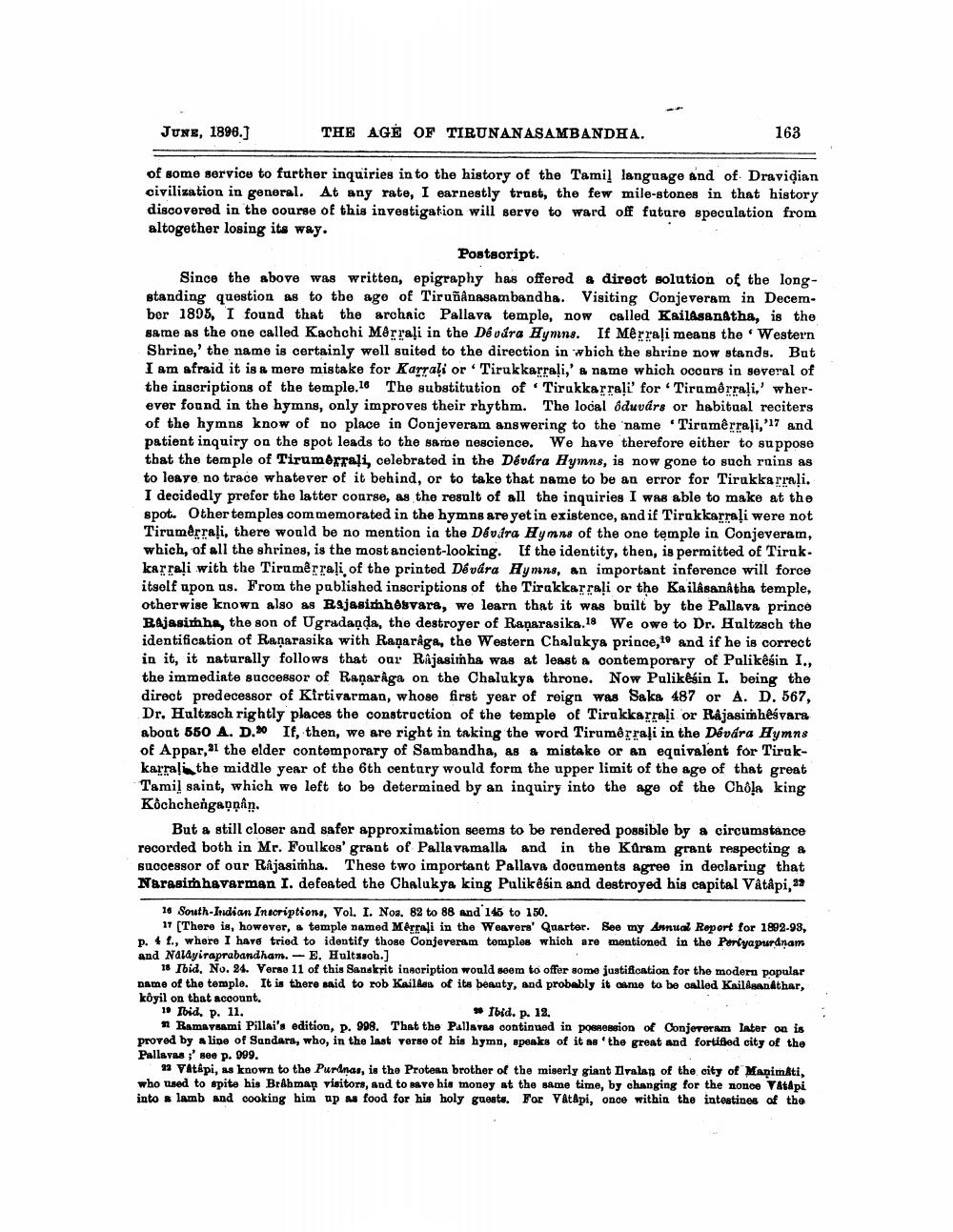________________
JUNE, 1896.)
THE AGE OF TIRUNANASAMBANDHA.
163
of some servicu to further inquiries in to the history of the Tamil language and of Dravidian civilization in general. At any rate, I earnestly trust, the few mile-stones in that history discovered in the course of this investigation will serve to ward off future speculation from altogether losing its way.
Postscript. Since the above was written, epigraphy has offered a diroot solution of the longstanding question as to the age of Tiruñânasambandha. Visiting Conjeveram in Decembor 1895, I found that the archaic Pallava temple, now called Kailasanatha, is the same as the one called Kachchi Mérraļi in the Dévára Hymns. If Mêrrali means the Western Shrine,' the name is certainly well suited to the direction in wbich the shrine now stands. But I am afraid it is a mere mistake for Karrali or Tirukkarrali,' a name which occurs in several of the inscriptions of the temple.16 The substitution of Tirukkarraļi' for Tirumêrrali,' wherever found in the hymns, only improves their rhythm. The local ôduvárs or habitual reciters of the hymns know of no place in Conjeveram answering to the name "Tiramêrrali,'17 and patient inquiry on the spot leads to the same nescience. We have therefore either to suppose that the temple of Tirumorrali, celebrated in the Dévára Hymns, is now gone to such rnins as to leave no trace whatever of it behind, or to take that name to be an error for Tirukkarrali. I decidedly prefer the latter course, as the result of all the inquiries I was able to make at the spot. Other temples commemorated in the hymns are yet in existence, and if Tirakkarraļi were not Tirumérrali, there would be no mention in the Devira Hymns of the one temple in Conjeveram, which, of all the shrines, is the most ancient-looking. If the identity, then, is permitted of Tiruk. karrali with the Tirumêrrali, of the printed Dévára Hymns, an important inference will force itself upon us. From the pablished inscriptions of the Tirakkarraļi or the Kailâsanatha temple, otherwise known also as Rojasimhosvara, we learn that it was built by the Pallava prince BAjasimhs, the son of Ugradaņda, the destroyer of Raņarasika.18 We owe to Dr. Hultzsch the identification of Ranarasika with Ranaråga, the Western Chalukya prince, and if he is correct in it, it naturally follows that our RÂjasimha was at least a contemporary of Polikêáin I., the immediate successor of Ranaraga on the Chalukya throne. Now Pulikesin I. being the direct predecessor of Kirtivarman, whose first year of reign was Saka 487 or A. D. 567, Dr. Hultzsch rightly places the construction of the temple of Tirukkarraļi or Rajasimhêávara about 550 A. D. If, then, we are right in taking the word Tirumêrraļi in the Dévára Hymns of Appar, 31 the elder contemporary of Sambandha, as & mistake or an equivalent for Tirukkarrali the middle year of the 6th century would form the upper limit of the age of that great Tamil saint, which we left to be determined by an inquiry into the age of the Chôļa king Kochchenga nîn.
But a still closer and safer approximation seems to be rendered possible by a circumstance recorded both in Mr. Foulkos' grant of Pallavamalla and in the Kdram grant respecting & successor of our Rajasimha. These two important Pallava docaments agree in declaring that Narasimhavarman I. defeated the Chalukya king Pulikesin and destroyed his capital Våtâpi, 22
16 South Indian Inscriptions, Vol. I. Noa. 82 to 88 and 145 to 150.
17 [There is, however, a temple named Mêrraļi in the Weavers' Quarter. See my Annual Report for 1892-98, p. 4 f., where I have tried to identify those Conjereram temples which are mentioned in the Portyapuranam and Nalayiraprabandham. - E. Hultssch.]
18 Ibid, No. 24. Vorne 11 of this Sanskrit inscription would seem to offer some justification for the modern popular name of the temple. It is there and to rob Kaillea of its beauty, and probably it came to be called Kailasanathar, köyil on that account. 1. Toid. p. 11.
* Ibid. p. 12. n Ramaykami Pillai's edition, p. 998. That the Pallaves continued in ponosion of Conjeceram later on is proved by a line of Sundari, who, in the last verse of his hymn, speaks of it as 'the great and fortified city of the Pallavas ;' see p. 099.
11 VAt&pi, as known to the Puranas, is the Protean brother of the miserly giant Ilvalan of the city of Manimati, who used to spite his Brahmar visitors, and to save his money at the same time, by changing for the nonce V&tapi into a lamb and cooking him up as food for his holy guests. For Våt&pi, once within the intestines of the




